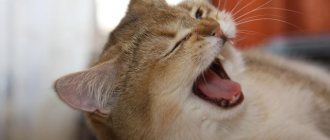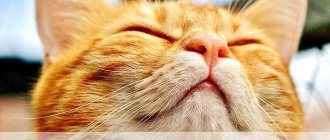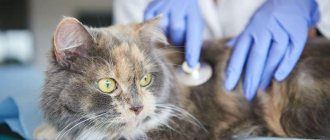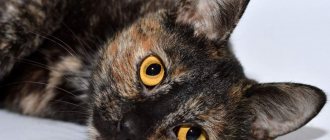Absolutely everyone sneezes - both animals and people. This phenomenon is absolutely normal and does not always indicate the presence of a disease. Sometimes the reason lies in allergies or dust getting into the nose. But when a cat sneezes, often and constantly, the owner begins to worry. It is very important to find out the causes of sneezing, and then take the necessary preventive and treatment measures. Read on to learn why cats sneeze, what to do, how to treat illnesses at home, and when to go to the vet.
What to do if your cat sneezes
First of all, the animal should be isolated in a separate room from other animals. Hold off on bathing, avoid visiting the street and communicating with stray cats, which carry most serious illnesses.
Possible reasons
A number of reasons for this behavior of cats have been noted. The most common:
- The dustiness of the room where the cat is located. Sneezing is caused by construction work during repairs and a long absence of wet cleaning.
- Allergy. Allergens in the air cause a similar reaction in animals. The most dangerous is the pest control agent.
- Finding a foreign body in the nose. When sneezing, small parts come out of the nostrils on their own, and large parts have to be removed by the owner or doctor. If your kitten has inhaled something and cannot get rid of it, you should seek help from a veterinarian.
- Infection with helminths. Worm infestations are often accompanied by sneezing. In addition, the pet suffers from shortness of breath and makes wheezing sounds.
- Infections. Due to the inflammatory process on the mucous membranes, the pet suffers from constant sneezing, fever, and lacrimation.
- Problems in the animal's mouth. It is necessary to treat gum diseases and neoplasms on the tissues of the nasopharynx.
- Whatever the cause, further therapy must be determined by your veterinarian. Self-medication can lead to complications or death of the animal.
Leave a request for a cat hotel
How to treat cat sneezing?
Treatment for cat sneezing is usually aimed at eliminating the underlying condition, if possible.
Although a wide range of treatment options are available, owners should be aware that the goal in most cases, especially chronic ones, is to reduce the frequency and severity of symptoms rather than cure them.
More research is needed to fully understand the role that infections play in feline sneezing, but repeated or long courses of antibiotics have been shown to be effective in controlling clinical signs.
Antibiotics
Although bacterial infections are rarely the main problem, antibiotics are often used in such cases as they make the cat feel better fairly quickly.
Nasal rinsing
Nasal lavage under general anesthesia may temporarily relieve clinical symptoms, regardless of cause, and may remove an occult foreign body.
What to pay attention to
If a deterioration in your pet’s health is noticed, it is worth observing what caused the malaise. It is necessary to determine the nature and frequency of sneezing, and monitor whether the symptom intensifies. Be sure to look for accompanying manifestations: suppuration of the eyes, heavy breathing, frequent cough, lack of appetite, and so on.
If your cat sneezes very often
Animals, like people, are susceptible to colds from drafts. Cats rarely get sick, but it can sometimes be observed. Usually weak individuals with reduced immunity get colds. It can be:
- old or sick animals;
- lambing cats;
- after vaccination or surgery;
- kittens;
A cold usually occurs with constant sneezing, fever, runny nose, and lethargy. The cat becomes passive, sleeps a lot, his nose and paw pads become hot.
If you sneeze and your eyes water
The cause of excessive discharge of fluid from the eyes of an animal can be both allergic reactions and infectious diseases. This reaction occurs to tobacco smoke, pollen, and decorative cosmetics of the housewife. Watery eyes also cause conjunctivitis. Inflammation of the internal tissues of the eye causes great suffering to pets. Troubles in the form of sneezing and the flow of tear fluid are often caused by common diseases - cataracts, glaucoma, keratitis.
If he sneezes and snorts
When looking for the reason why a cat is constantly sneezing, you should definitely look into his nose. Sometimes small objects get into the animal's nasal passages when inhaled. It is recommended to check if there is a foreign body there. Cats remove most of the garbage on their own; if something large is stuck, you can try to remove it with tweezers. This must be done very carefully, it is advisable to involve an assistant. In case of any difficulties, you must take your pet to a veterinarian.
If you sneeze while eating
Sometimes the cat's owner notices sneezing attacks during or after eating food. This is most likely due to an allergy to one or more of the constituent components. This product, which is responsible for such a reaction, should be excluded from the diet. You can offer your pet something else after carefully studying the composition of the nutritional mixture. Nasal polyps can also cause sneezing in a cat. They make breathing difficult, causing the animal to want to get rid of the interfering growths.
Is cat sneezing serious?
It depends on whether the cause is environmental or disease.
Sometimes the stimuli that trigger the sneeze reflex are related to the environment. This could be dust, mold or pollen that the cat inhales. In these cases, the sneezing is usually not serious, especially if it is a single episode.
However, more often than not, cat sneezing is caused by one or more diseases.
Most often, the initial problem is a viral infection, followed by inflammation and bacterial infections that cause damage to the internal structure of the nose, making the problem worse.
How to help a cat
If your cat's sneezing is not accompanied by accompanying symptoms, you can help the animal at home.
For example, dust getting into the respiratory tract is the safest reason. It is caused by the body's protective reaction. First of all, it is necessary to carry out wet cleaning or remove the pet from the dusty room. If an allergy occurs, it is recommended to remove the source of the allergen into the air from the room. It is best to purchase other household chemicals and change the type of toilet filler. If your pet sneezes from a houseplant, you should remove the houseplant as far as possible. Simply removing the stamens and pollen from flowers helps. As a rule, this is enough to eliminate unpleasant symptoms in the animal. To prevent infectious and colds, you need to add vitamins to your food and balance your pet’s diet. You should not postpone a visit to the veterinarian if your animal’s condition worsens.
Pet treatment
If, upon examination, the doctor does not identify any acute reason why the kitten is sneezing, then he may prescribe wet cleaning for preventive purposes and recommend purchasing a humidifier.
Any diseases of the respiratory tract will require the use of nasal agents to relieve swelling of the nasal mucosa. More serious complications are treated with antibiotics. After healing, the sneezing will go away on its own.
Polyps or other neoplasms are removed surgically if the veterinary clinic has special equipment and a properly qualified specialist. Otherwise, the pet may be sent to another clinic equipped with everything necessary.
Murkoshi specialists do not recommend trying to remove foreign objects in a cat’s nose at home: if you do not have the appropriate experience (and you probably don’t), you will only push the object even deeper and aggravate the cat’s already difficult condition. Instead, take your purr to the veterinary clinic. There, the specialist will remove the foreign body and recommend further treatment to relieve inflammation.
Read more: How to choose the right veterinary clinic for a cat?
If you have an allergy, you will need to take a test to identify the allergen. To relieve side effects (itching, swelling, sneezing, coughing), the veterinarian will prescribe antihistamines, antipruritics, diuretics, and, if necessary, antishock agents.
For infections, a specialist prescribes antibiotics, antiviral drugs and probiotics.
Read about infections: What are the types of infections in cats and how to treat them
When to see a doctor
A sick animal should definitely be seen by a veterinarian if, in addition to sneezing, the following are present:
- tearfulness, purulent discharge from the eyes;
- lack of air;
- coughing;
- pus, ichor from the nose;
- loss of appetite;
- restless rubbing of the nose with a paw, as if something is disturbing;
- wheezing;
- chills;
- hyperthermia;
- dry crusts near the nostrils;
- diarrhea;
It is difficult to figure out on your own the reason why your pet often sneezes. It is better to entrust your pet to a doctor, he will make an accurate diagnosis and prescribe adequate treatment.
Other possible causes of a runny nose
1. Caries. An infection in the oral cavity penetrates the nasopharynx, causing inflammation of the mucous membrane. As a result, the cat sneezes, its nose runs, and its eyes water. In this case, you need to contact a veterinarian to eliminate the cause of the runny nose.
2. Worms. Helminths are insidious creatures that can also cause runny noses in cats. Regularly - once every 3 months - give your pet anthelmintic drugs. This must be done because The cat is constantly licking something - the floor, the walls, street shoes, etc.
3. Allergies. Observe the animal's reaction to the aroma of your cosmetics/deodorants - perhaps they irritate the mucous membrane of his nose. Try to regularly clean the house of dust - it also serves as a powerful allergen for cats.
We are looking for reasons why a cat sneezes
To understand why a cat is sneezing, you need to examine your pet and observe him for some time - this will help determine the cause of the “sneeze” and consider additional symptoms of the disease, if any.
If a cat is sneezing because his nose is clogged with something foreign, or a foreign object has gotten into it, you can easily detect it yourself and, perhaps, help your pet yourself.
A simple examination will be enough to detect a problem with the cat’s teeth or gums: they can also cause sneezing. Having discovered one, you need to go to the doctor, since you yourself will not be able to cure an ascending infection from the mouth to the nose.
If the nose is clean and the cat sneezes regularly: after eating, contact with the litter box, when the owner smokes or spraying air freshener or hairspray - it is very likely that your cat is allergic, and maybe you just need to stop smoking at home and not spray the air freshener in the presence of a cat.
If a cat begins to sneeze, and at the same time his nose is running, his eyes are watery, his temperature is elevated, he has an increased cough, the animal is lethargic and refuses to eat - the situation is alarming. Such symptoms may be signs of serious viral diseases (herpes, toxoplasmosis, chlamydia, mycoplasmosis and others). If the discharge from the nose is bloody, we can talk about polyps in the nasal cavity or a tumor.
In the case of any illness, only a veterinarian can explain what to do if a cat sneezes. And only after a thorough examination, which necessarily includes smears and blood tests. Your observations can serve as an aid to the doctor, but in no case are they the basis for making a diagnosis.
The only way not to be tormented by the question of why and why the cat began to sneeze, and what to do, is to vaccinate your tailed cat in a timely manner. Regular vaccinations will help protect your animal from most dangerous diseases and disturbing “sneezes”.
Now let's look at the reasons for this phenomenon. I would like to note that if your pet sneezed once, then there is no need to worry. This phenomenon is quite natural. But if a cat sneezes often, then the owner should think twice about it. After all, it could be either the flu or an allergy.
How to wash your nose
If a domestic cat sneezes, it is better to do the rinsing yourself with regular saline solution or chlorhexidine 0.05%, which can be bought at a pharmacy, or 0.9% saline solution. It is best to carry out the procedure as often as possible, every 3-4 hours, until the symptoms stop.
Rinsing the nose is not a very pleasant procedure; be prepared that the cat may behave aggressively. It is better if the procedure is performed by two people, prepare everything you need in advance and do not forget to put gauze napkins nearby. Algorithm of actions:
- Heat the solution to body temperature.
- Draw liquid into a syringe without a needle - it is better to take a thin insulin one. An intravenous catheter without a needle is well suited for this purpose; a thin tube will allow you to perform the procedure faster and more efficiently.
- Secure the animal by holding it by the forelimbs in a lying position. You can also sit the cat on your lap, having previously wrapped it in a towel or thick cloth, and if there is no assistant, then squeeze it between them.
- Then, with one hand, lift the cat’s head up and slowly pour the solution, first into one, then into the other nostril (about 0.5 ml of solution for each), taking breaks so that the animal can sneeze to get rid of the liquid.
- Blot the animal's face with a napkin, removing any remaining solution and secretions.
Best articles: What are the largest rivers on Earth - list, characteristics and photos
It is best to instill drops, if necessary, immediately after rinsing, so do not loosen your “grip”!











